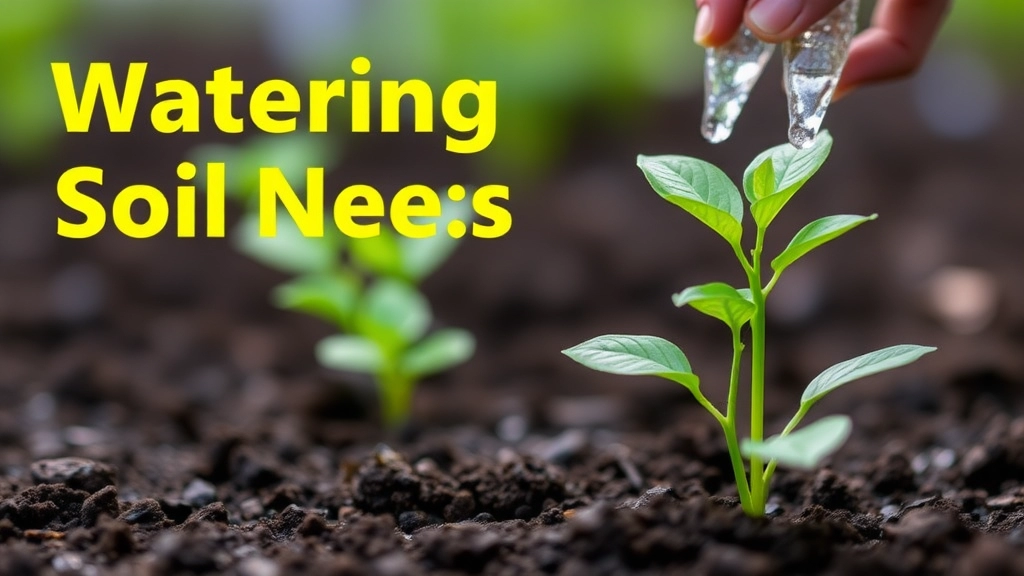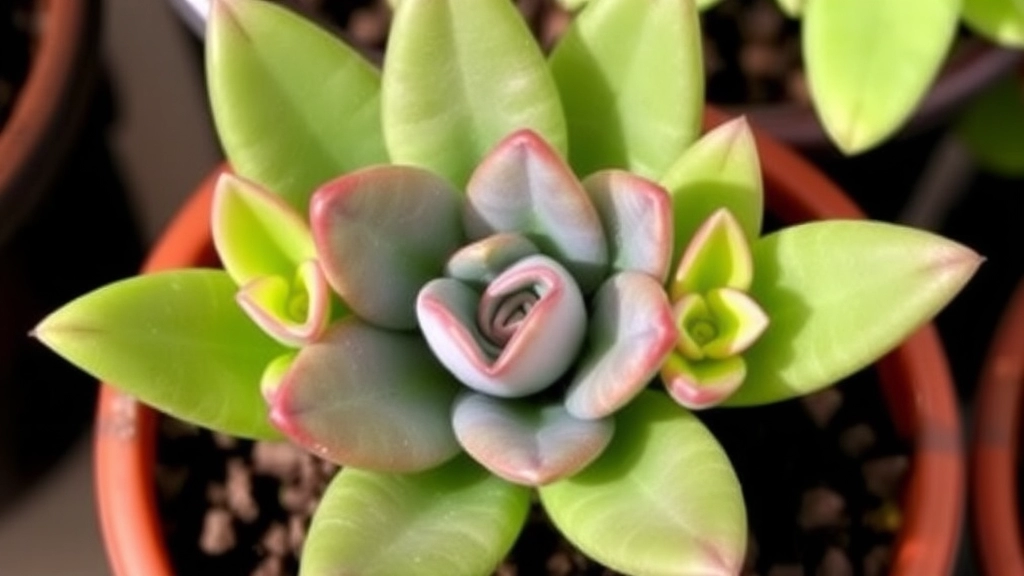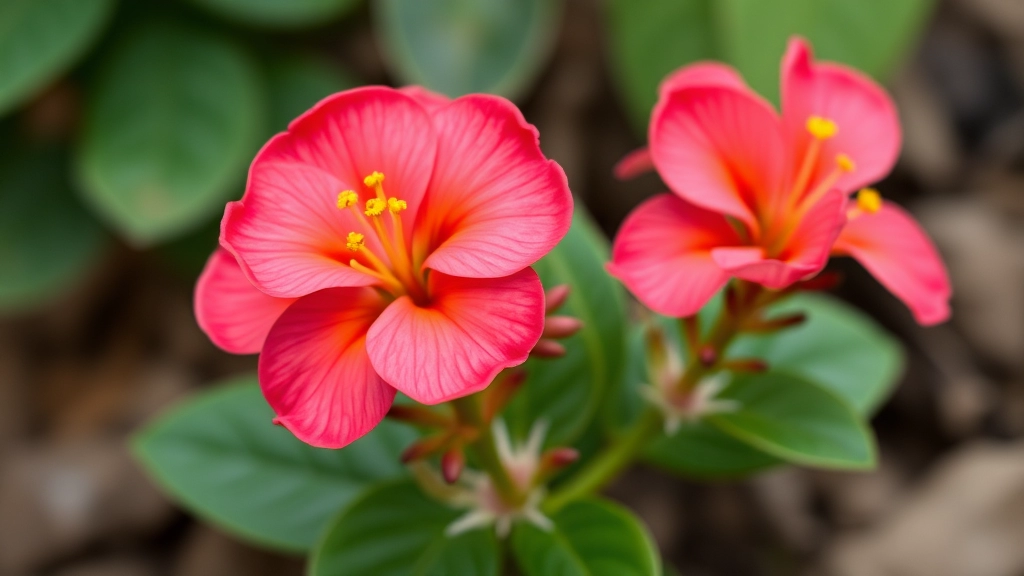Curious about the Hawaiian Kalanchoe Flower?
You’re in the right place! This vibrant succulent, known for its long-lasting blooms, is a favourite among gardeners and indoor plant enthusiasts. It’s perfect for those who want a low-maintenance yet attractive addition to their homes. Let’s dive into the essentials of caring for this tropical beauty.
Caring for the Hawaiian Kalanchoe
First things first, the Hawaiian Kalanchoe thrives in warm, dry conditions. Proper watering and soil are crucial for healthy growth, while the right fertilising techniques can encourage stunning blooms. Whether you’re looking to propagate new plants or tackle common issues like pests and diseases, we’ve got you covered with practical tips and solutions.
Optimal Environmental Conditions for Hawaiian Kalanchoe
When considering the ideal environment for your Hawaiian Kalanchoe, you might wonder what specific conditions will help it thrive.
Hawaiian Kalanchoe, with its vibrant blooms and succulent leaves, flourishes in environments that mimic its native habitat.
Light Requirements
- Bright, Indirect Light
- Hawaiian Kalanchoe prefers bright, indirect sunlight.
- Too much direct sunlight can scorch the leaves, while too little can hinder blooming.
Temperature Preferences
- Warm Temperatures
- Ideal temperatures range between 18°C to 24°C (65°F to 75°F).
- Protect your plant from cold drafts and sudden temperature changes, as it is sensitive to the cold.
Humidity Levels
- Moderate Humidity
- Hawaiian Kalanchoe thrives in moderate humidity levels.
- If your home is particularly dry, consider misting your plant occasionally or placing it on a humidity tray.
Air Circulation
- Good Airflow
- Ensure there is good air circulation around your plant.
- This helps prevent fungal diseases and keeps the leaves healthy.
For more information on the care of similar plants, check out our expert tips on caring for Kalanchoe succulents. Additionally, if you are interested in exploring more varieties, our comprehensive list of Kalanchoe species is a great resource.
Watering and Soil Needs for Healthy Growth

So, you’ve got your Hawaiian Kalanchoe, and now you’re wondering how to keep it thriving, right?
Let’s dive into the nitty-gritty of watering and soil needs because these are crucial for a happy plant.
Watering Essentials
First things first: Hawaiian Kalanchoe loves a good drink, but it’s all about balance. Overwatering can lead to root rot, which is a nightmare for any plant parent. Here’s what you should keep in mind:
- Frequency: Water every 2-3 weeks, but always check the soil first. Stick your finger in about an inch deep; if it’s dry, it’s time to water.
- Technique: Water deeply until you see it draining out the bottom of the pot. This encourages strong root growth.
- Seasonal Adjustments: In winter, cut back on watering as the plant goes dormant. It’s like letting it take a little nap!
Soil Requirements
Now, let’s talk soil. Hawaiian Kalanchoe thrives in well-draining soil to avoid soggy roots. Here’s how to set it up:
- Soil Type: Use a cactus or succulent mix, which is light and airy.
- DIY Mix: If you’re feeling crafty, mix regular potting soil with perlite or sand to improve drainage.
- Pot Choice: Opt for pots with drainage holes. This is a game-changer for keeping your plant healthy.
So, remember: water when the soil is dry, use well-draining soil, and choose the right pot.
Fertilizing and Encouraging Blooming in Hawaiian Kalanchoe
After establishing the right environment and understanding watering needs, it’s time to focus on fertilizing and encouraging blooming in your Hawaiian Kalanchoe.
Many gardeners wonder how to coax their Kalanchoe into a vibrant display of flowers.
Fertilizing Basics
To promote healthy growth and abundant blooms, consider the following:
- Type of Fertilizer: Use a balanced, water-soluble fertilizer, ideally one with a higher phosphorus content. Look for formulations like 10-30-20, which support blooming.
- Frequency: Fertilize every 4-6 weeks during the growing season (spring and summer). Reduce or halt fertilization in the fall and winter when the plant enters dormancy.
- Dilution: Always dilute the fertilizer to half the recommended strength to avoid over-fertilizing, which can harm your plant.
Encouraging Blooms
To encourage blooming, keep these tips in mind:
Propagation Techniques for Hawaiian Kalanchoe

Are you looking to expand your collection of Hawaiian Kalanchoe or share them with friends? Propagation is a rewarding and straightforward process that can enhance your gardening experience.
1. Leaf Cuttings
One of the simplest methods is through leaf cuttings. Here’s how to do it:
- Select a healthy leaf from the parent plant.
- Use a clean, sharp knife to cut the leaf at the base.
- Allow the cutting to dry for a few hours until the cut surface calluses over.
- Place the leaf on well-draining soil, ensuring the cut end is in contact with the soil.
- Water lightly and keep it in a warm, bright location.
2. Stem Cuttings
Stem cuttings are another effective way to propagate Hawaiian Kalanchoe. Follow these steps:
- Choose a healthy stem with a few leaves.
- Cut the stem just below a leaf node.
- Remove the lower leaves to expose the stem.
- Let the cutting dry for a day or two.
- Plant it in well-draining soil and water sparingly.
3. Offsets
Hawaiian Kalanchoe often produces offsets, which can be easily separated:
- Look for small plants growing at the base of the parent.
- Gently remove them, ensuring some roots are attached.
- Replant them in individual pots with suitable soil.
4. Seeds
While less common, propagation from seeds is possible:
- Sow seeds in a seed tray filled with a light soil mix.
- Keep the tray moist and in a warm location.
- Once seedlings appear, transplant them into pots.
These methods not only provide you with new plants but also deepen your connection with your Hawaiian Kalanchoe.
Common Issues: Pests, Diseases, and Solutions
As we nurture our Hawaiian Kalanchoe, it’s essential to remain vigilant against potential threats that could hinder its health and beauty.
Pests to Watch For
Hawaiian Kalanchoe can attract various pests that may compromise its growth. Here are some common culprits:
- Mealybugs: These tiny, white insects can cluster on leaves and stems, sucking the sap and causing wilting.
- Aphids: Small and green, they can cause stunted growth and distort new leaves.
- Spider Mites: Often found on the undersides of leaves, they create fine webbing and can lead to leaf drop.
Solution: Regularly inspect your plants. If you spot pests, treat them with insecticidal soap or neem oil. For severe infestations, consider removing affected leaves.
Diseases to Be Aware Of
While pests are a concern, diseases can also affect Hawaiian Kalanchoe. The most common include:
- Root Rot: Caused by overwatering, it leads to mushy roots and wilting foliage.
- Powdery Mildew: This fungal disease appears as a white powdery coating on leaves, often due to high humidity and poor air circulation.
Solution: Ensure proper watering practices. For root rot, allow the soil to dry out completely before watering again. For powdery mildew, improve air circulation and apply a fungicide if necessary.
Preventative Measures
To keep your Hawaiian Kalanchoe thriving, consider these preventative steps:
- Water Wisely: Allow the soil to dry out between waterings. For more detailed advice, check our best soil for Kalanchoe Blossfeldiana care tips.
- Maintain Airflow: Space plants adequately to prevent humidity buildup.
- Regular Inspections: Check for signs of pests or diseases weekly. For comprehensive care, visit our complete care guide for Kalanchoe Beharensis.
By staying proactive, you can ensure that your Hawaiian Kalanchoe remains vibrant and healthy.
FAQs on Hawaiian Kalanchoe Flower Care and Propagation
How often should I water my Hawaiian Kalanchoe?
Water your Hawaiian Kalanchoe every 2-3 weeks. Always check the soil first by sticking your finger about an inch deep; if it’s dry, it’s time to water. Overwatering can lead to root rot, so balance is key.
What type of soil is best for Hawaiian Kalanchoe?
Hawaiian Kalanchoe thrives in well-draining soil. Use a cactus or succulent mix, or create your own by mixing regular potting soil with perlite or sand to improve drainage. Ensure your pot has drainage holes to avoid soggy roots.
How can I propagate my Hawaiian Kalanchoe?
There are several methods to propagate Hawaiian Kalanchoe:
- Leaf Cuttings: Cut a healthy leaf, let it dry until callused, and place it on well-draining soil.
- Stem Cuttings: Cut a healthy stem below a leaf node, let it dry, and plant it in well-draining soil.
- Offsets: Separate small plants growing at the base of the parent and replant them.
- Seeds: Sow seeds in a light soil mix, keep moist, and transplant seedlings into pots.
Do I need to adjust watering during different seasons?
Yes, adjust your watering schedule according to the seasons. In winter, reduce watering as the plant goes dormant. It’s like letting it take a little nap!
What kind of pot should I use for my Hawaiian Kalanchoe?
Opt for pots with drainage holes. This is crucial to prevent water from accumulating at the bottom, which can lead to root rot. Well-draining soil and proper pots are a game-changer for keeping your plant healthy.
Can I propagate Hawaiian Kalanchoe from seeds?
Yes, while less common, you can propagate Hawaiian Kalanchoe from seeds. Sow the seeds in a seed tray with a light soil mix, keep the tray moist and in a warm location, and transplant the seedlings once they appear.
What are the signs of overwatering my Hawaiian Kalanchoe?
Signs of overwatering include yellowing leaves, mushy stems, and root rot. Always ensure the soil is dry before watering and use well-draining soil to prevent these issues.
Why is it important to let cuttings dry before planting?
Allowing cuttings to dry before planting helps the cut surface callus over, reducing the risk of rot and increasing the chances of successful propagation. This step is crucial for both leaf and stem cuttings.
References
-
Kalanchoe Plant Care â How To Grow A Kalanchoe
-
How to Grow Kalanchoe Indoors
-
Kalanchoe Plant Care and Growing Guide
